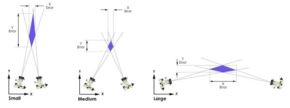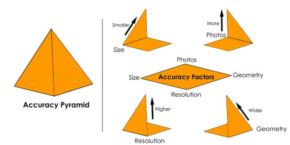
The short answer is V-STARS is very accurate and provides accuracies comparable to those achieved by other large volume, high accuracy coordinate measurement systems such as Digital Theodolites, Co-ordinate Measuring Machines (CMMs), and Laser Trackers. Typical accuracies are 25 to 50 microns (0.001″ to 0.002″) on a 3-meter (ten foot) object.
The long answer is a bit more complex since accuracy depends on several inter-related factors. The most important are:
1. The resolution of the camera you are using,
2. The size of the object you’re measuring,
3. The number of photographs you’re taking, and
4. The geometric layout of the camera stations (camera locations) relative to the object and to each other.
The effect of each of these factors is described briefly below.
Resolution
The resolution of the camera you’re using is a major factor in determining the overall accuracy of V-STARS. V-STARS is able to measure the centers of images to better than 1/50th (0.020) of a pixel typically. For a 2,000 by 2,000 pixel camera such as the KODAK Megaplus 4.2, this represents an inherent accuracy of 1 part in 100,000 (2000/0.020). Other factors mentioned above will increase or decrease this inherent accuracy. Cameras with fewer pixels will have lower inherent accuracy. Cameras with more pixels have a higher inherent accuracy.
Object Size
The absolute accuracy of V-STARS depends on the size of the object being measured. Given the 1 part in 100,000 inherent accuracy mentioned above means a measurement accuracy of 50 microns (0.002″) will be achieved on a 5 meter (15 foot) object (5 meters/100,000 = 50 microns), 100 microns (0.004″) will be achieved on a ten meter (30 foot) object (10 meters/100,000 = 100 microns), and so on.
One technique you can use to increase accuracies is to move in closer, and photograph the object in sub-sections. For example, a ten meter object can be measured to an accuracy of 50 microns instead of 100 microns by photographing the object in five meter sections. Of course this requires taking more photographs (usually at least twice as many) since the typical photograph sees only a fraction of the object. One can increase absolute accuracies considerably by using this technique, but the measurement becomes increasingly complex. One key to using this technique successfully is to ensure there is enough overlap among all the photographs to provide a good solution.
Number of Photographs
All other factors being equal, increasing the number of photographs will increase the accuracy of the measurement. Since V-STARS measures by triangulation, each target must be measured in at least two photographs for the point to be triangulated. If a target is seen in more than two photographs, the accuracy will increase. However, the accuracy increase is not linear. As a rule of thumb, the accuracy increases with the square root of the increase in the number of photographs. So, to increase the accuracy of a two-photo measurement by a factor of two, you must take not twice as many photographs but four time as many, or eight in this case. To increase accuracy by another factor of two, you would have to take 32 photographs. Obviously, one quickly reaches a point of diminishing returns when simply taking more photographs to increase accuracy.
That said, it is worth mentioning that additional photographs also increase reliability because they reduce the influence of poor measurements. For that reason, we recommend trying to have each target seen in at least three (and preferably four) photographs. These pictures should be taken from different stations.
Geometry
Since V-STARS measures by triangulation, the geometry of the camera stations can have a considerable influence on measurement accuracy. Typically, one should try to get intersection angles of 90° or so between the lines of sight of the camera stations for the best results. Smaller intersection angles will progressively reduce accuracies. The figure below illustrates this. The thin lines around the thick lines show how errors in detecting the true centroid of target image produce errors in determining the location of the target

Final Discussion on Accuracy
As you can see from the above discussion, accuracies can vary considerably. However, if you use the INCA camera, and take six to eight photographs with good geometry, and each photograph sees the entire object you should obtain accuracies of 25 to 50 microns (0.001″ to 0.002″) on a 15 foot object.
The effects of the four factors mentioned above on accuracy are illustrated by the diagram below. The diagram can be thought of as a pyramid with the four factors at the base of the pyramid and high accuracy at the top of the pyramid. To get higher accuracy ( a higher pyramid) you need more of the items shown on the lines of pyramid (higher resolution, smaller size, more photos, wider (not too wide though) geometry).